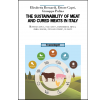The Sustainability of Meat and Cured Meats in Italy. Nutritional Aspect, Food Safety, Environmental Impact, Animal Welfare, Circular Economy, Fight Against Waste
Synopsis
Released under the Creative Commons License Attribution-NonCommercial-NoDerivatives 4.0 International (CC BY-NC-ND 4.0) in the peer reviewed series Uomo, ambiente, sviluppo
From the mid-1980s, meat consumption in Italy and the western world have stabilised and, in the face of a well-established food security, we have witnessed a changed sensitivity for ethical issues, such as animal welfare and environmental impacts of farms.
The challenge of livestock production has therefore become that of “producing more with less resources”, a challenge at the base of the circular economy, which sets itself the goal of a greater offer, but more “sustainable”, efficient, attentive to the environment and animal welfare, to the fair remuneration of breeders and all those who participate in the creation of value in Italian supply chains.
Analysing the sustainability of meat and cured meats means studying in the most objective way possible different topics concerning both the consumer and the livestock production.
This volume presents an interdisciplinary study to describe the “5 faces” of meat sustainability, represented by as many chapters: nutrition, environmental impacts and the circular economy applied to farms and industry, food security and animal welfare, the economic aspects of supply chains and the fight against food waste.
The consumption of meat is increasingly subject to attention and criticism principally linked to nutritional, ethical and environmental reasons. In this context, the point of view of meat producers has never been introduced, who instead have the need to participate in the discussion providing information, details and objective data useful to examine the topic.
With this objective, in 2012, the Carni Sostenibili project was born, which in uniting the main Associations of producers, has the intent to bring to people’s attention the results of the commitments of the various operators of the sector offering a point of view for a constructive and transparent confrontation, free from preconceptions and extreme positions, and driven by the desire for scientific and objective analysis.
This text rigorously deals with some popular subjects in public opinion which often end up being trivialized in commonplaces and sometimes transformed into fake news. To mention only a few: the environmental impact of livestock farming; meat and the diet of Mediterranean
countries; real consumption of meat in Italy and in the world; use of antibiotics on animals; the relationship between meat and some diseases; what WHO really said on meat.
Thanks to this book, we have a complete and scientific instrument, enriched in sources and updated information, for anyone who is interested in starting a loyal debate on the issue of “meat” free from ideologies and prejudices.
Downloads


